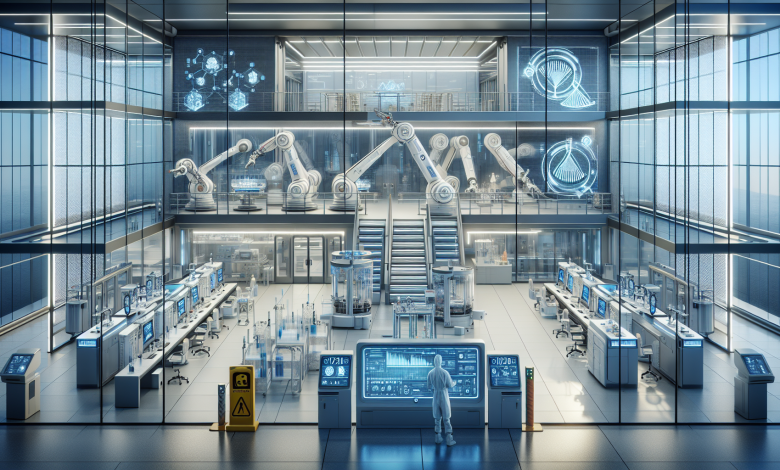Enhancing Scientific Breakthroughs with Advanced Laboratory Technology

The traditional image that often springs to mind when it comes to envisioning a laboratory setting is rows of glassware, the soft hum of equipment, and walls lined with reference books. However, stepping into modern science research facilities reveals a vastly different scene. Here, the integration of cutting-edge technology with innovative design is catalyzing notable advances in scientific research.
The evolution within these spaces is marked by the fusion of sophisticated laboratory designs and advanced technological tools. This combination is not only supporting but significantly accelerating innovation in various scientific fields.
The Evolution of Laboratory Equipment
The constraints that once limited scientific exploration due to outdated tools are progressively diminishing. Modern laboratories boast an arsenal of technologies previously unthinkable, transforming the landscape of scientific research.
Imagine devices capable of sequencing entire genomes within hours, predictive modeling software for complex chemical reactions or artificial intelligence systems analyzing vast datasets with pinpoint precision. These tools are at the forefront of science, propelling research into new frontiers. From bustling biotech startups in collaborative Massachusetts labs to expansive pharmaceutical corporations, the quest for leveraging these advanced technologies for swifter and more productive research endeavors is fierce.
The integration of automation and robotics into laboratory processes has been a game-changer. Automated liquid handling systems, high-throughput screening platforms and robotic sample preparation have not only improved the efficiency and reproducibility of experiments but have also freed up valuable time for researchers to focus on more complex tasks. These technologies have transformed the way experiments are designed and executed, enabling scientists to tackle more ambitious projects and accelerate the pace of discovery.
How Lab Design Influences Scientific Discovery
The impact of a lab’s physical layout on scientific innovation cannot be overstated. Picture a scenario where open, airy spaces encourage spontaneous discussions among researchers or where entities like LabShares in Massachusetts provide biotech start-ups with access to fully-equipped labs, eliminating considerable logistical burdens. Such environments are deliberately crafted to nurture collaboration, creative problem-solving and an interdisciplinary approach to research. In these innovative spaces, the focus shifts from mundane operational details to the core of scientific discovery, enabling researchers to pursue groundbreaking work with renewed vigor.
What’s more, the incorporation of flexible and modular lab designs has become increasingly popular. These adaptable spaces allow laboratories to evolve and reconfigure as research needs change over time. Movable benches, adjustable shelving and multi-purpose equipment enable researchers to optimize their workspaces for specific projects, fostering a more efficient and dynamic research environment. By embracing these flexible design principles, laboratories can stay agile and responsive to the ever-changing demands of scientific inquiry.
Emphasizing Safety in State-of-the-Art Laboratories
Amid the excitement surrounding the technological prowess of modern labs, the critical importance of safety remains paramount. Handling hazardous materials, ensuring the safe development of medications, and overseeing safe experimental procedures are fundamental aspects of contemporary research practices.
Today’s laboratories prioritize not just innovation but also the stringent adherence to safety protocols. Regulatory agencies are instrumental in establishing and enforcing these safety measures, ensuring a secure environment where scientific inquiry can proceed without compromising researcher welfare or research integrity.
In addition to physical safety measures, modern laboratories also prioritize digital security. With the increasing reliance on digital data and the need for secure data storage and sharing, robust cybersecurity protocols have become essential. Laboratories must implement strict access controls, encrypt sensitive data and regularly update their digital infrastructure to protect against potential breaches. By safeguarding both physical and digital assets, modern laboratories can ensure the integrity and confidentiality of their research, maintaining the trust of their stakeholders and the public.
The Path from Laboratory Discoveries to Societal Impact
The transit from a nascent laboratory discovery to its application in the real world is intricate and multifaceted. Nonetheless, modern laboratories facilitate this journey by fostering an ecosystem conducive to collaboration across academic, start-up and industrial landscapes.
The setups provide not just the technological tools but also the collaborative framework essential for innovation. This synergy accelerates the development of groundbreaking treatments, technologies and products, showcasing the dynamic interplay between optimal resources, conducive environments, and rigorous safety standards in bringing scientific aspirations to fruition.
Summing Up
The scientific research landscape is undergoing a remarkable transformation, propelled by the advancements in laboratory technology and design. The amalgamation of state-of-the-art equipment, collaborative spaces, and stringent safety norms is foundational to the current surge in scientific discoveries. Modern laboratories serve as pivotal platforms for this wave of innovation, embodying the confluence of discovery, safety, and interdisciplinary collaboration that is shaping the future of science.





